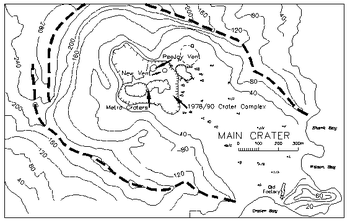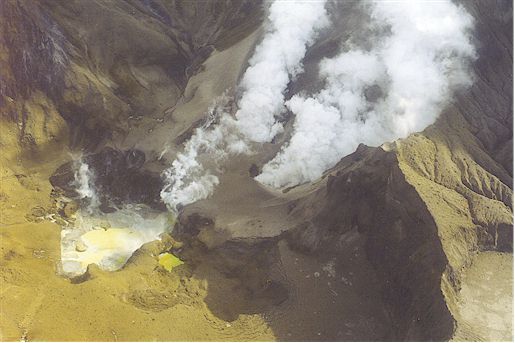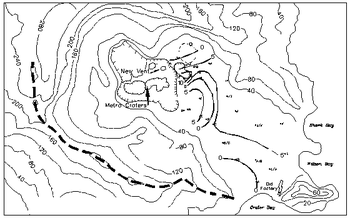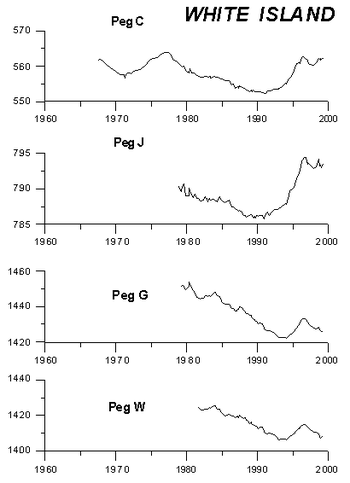
Science Alert Bulletin WI-1999/09 - White Island Volcano
3 May 1999, 4:00 pm - Update
No further explosive eruptions have occurred at White Island since the events on 17 April which re-excavated Metra Crater, destroying the lakelet that had recently occupied it and forming a new vent east of the PeeJay Vent. Ballistic ejecta from the 17 April events fell out to over 450m from the Metra area.
Outlined below are observations following a visit on Friday (30 April) to service the seismic installation, conduct a deformation survey and assess the affects of the April explosive eruptions and any later activity. No further explosive eruptions have occurred, however the likelihood that similar explosive eruptions will occur again, with little or no warning, remains high. PeeJay Vent, and the new vent east of it remain active, but were not emitting ash during Friday’s visit.
Observations
During our visit a steam and gas plume was rising 750 - 900m, travelling south-west. Local winds were 15 - 18knots from the north-east. The steam and gas plume was being fed by emissions from PeeJay vent and the new vent to the east of PeeJay.
The April explosions have re-excavated the Metra Crater area to form two features (Figures 1 and 2). The western embayment is the deeper and more active. A small yellow/green lakelet has already formed on the floor of this feature. The western margins are still actively collapsing, and several large geothermal features are present. Geyser-like activity is occurring in some of the pools. The strongest fumarole vents are on the northwest side, emerging from the base of the crater wall which is about 8 - 10m high. The eastern embayment is shallower and does not contain any active geothermal features. One small yellow/green lakelet is present at the western end of this feature. Several open concentric fractures extend around the margins, and indicate further collapse may occur in this area.
A ground deformation survey of the pegs which survived the April explosions was also made. Seven pegs could not be found. The survey shows subsidence continues about the eastern-southeastern margin of 1978/90 Crater complex (Figure 3), but at a lesser rate than observed in 1998. Over the remainder of the Main Crater floor weak inflation is apparent at many of the marks. Although deflationary trends have been observed at some marks since eruptions commenced in 1998, many remain elevated at this time (eg. Pegs C and J). This would tend to indicate further eruptions are likely. Time series plots for selected marks are shown in Figure 4.
No further explosive eruptions have occurred at White Island since the events on 17 April which re-excavated Metra Crater, destroying the lakelet that had recently occupied it and forming a new vent east of the PeeJay Vent. Ballistic ejecta from the April 17 events fell out to over 450m from the Metra area. Outlined below are observations following a visit on Friday (30 April) to service the seismic installation, conduct a deformation survey and assess the affects of the April explosive eruptions and any later activity. No further explosive eruptions have occurred, however the likelihood that similar explosive eruptions will occur again, with little or no warning, remains high. PeeJay Vent, and the new vent east of it remain active, but were not emitting ash during Friday’s visit.
Observations
During our visit a steam and gas plume was rising 750 - 900m, travelling south-west. Local winds were 15 - 18knots from the north-east. The steam and gas plume was being fed by emissions from PeeJay vent and the new vent to the east of PeeJay.
The April explosions have re-excavated the Metra Crater area to form two features (Fig. 1, 2). The western embayment is the deeper and more active. A small yellow/green lakelet has already formed on the floor of this feature. The western margins are still actively collapsing, and several large geothermal features are present. Geyser-like activity is occurring in some of the pools. The strongest fumarole vents are on the northwest side, emerging from the base of the crater wall which is about 8 - 10m high. The eastern embayment is shallower and does not contain any active geothermal features. One small yellow/green lakelet is present at the western end of this feature. Several open concentric fractures extend around the margins, and indicate further collapse may occur in this area.
A ground deformation survey of the pegs which survived the April explosions was also made. Seven pegs could not be found. The survey shows subsidence continues about the eastern-southeastern margin of 1978/90 Crater complex (Fig. 3), but at a lesser rate than observed in 1998. Over the remainder of the Main Crater floor weak inflation is apparent at many of the marks. Although deflationary trends have been observed at some marks since eruptions commenced in 1998, many remain elevated at this time (eg. Pegs C and J). This would tend to indicate further eruptions are likely. Time series plots for selected marks are shown in figure 4.







